«- back to print version table of contents
50 dBZ Echo Top Height
Detection
A 50 dBZ Echo Top signature refers to the height of the highest echo that is greater than 50 dBZ within a storm’s radar reflectivity core. This signature can be found in any thunderstorm with echoes of at least 50 dBZ. One reason for determining if this signature is present is to see whether a storm's 50 dBZ core, which is likely to represent hail when located above the freezing level, reaches into or beyond the hail growth layer (-10°C to -30°C).
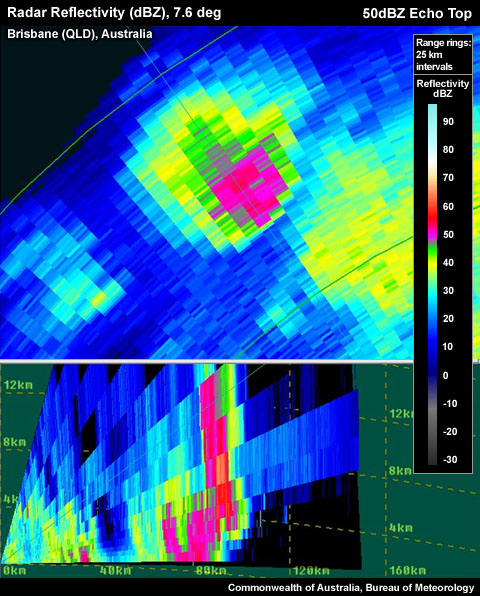
The 50 dBZ Echo Top Height signature in this example shows echoes above 50 dBZ high in the atmosphere, extending into the hail growth layer and increasing the likelihood that the targets are large hail. The thunderstorm in this reflectivity image has 50 dBZ and greater echoes extending to around 12km.
The 50 dBZ echo height can be determined as follows:
Reflectivity: PPI/Plan View
- Step up in elevation scans until you run out of >50 dBZ echoes.
- Step back down one elevation scan.
- Centre cursor over the >50 dBz pixel furthest away from the radar. Read off the height. Note: In 3D-Rapic this can be done using the scale bar on the right of display, the info bar at the bottom of display or via the cursor data on the main control window.
The 50 dBZ echo top signature can also be used as a monitoring tool for forecasters. The following technique requires the use of environmental parameters in conjunction with a Constant Altitude PPI (CAPPI) window. The basic idea of this monitoring technique is to place a CAPPI level into the middle to upper parts of the hail growth layer and to monitor for significant (>50 dBZ) reflectivity cores to grow beyond the CAPPI level as an indicator for storm severity. In this technique, rather than placing the CAPPI at the -20°C level, a Sydney-based climatology is used (the "hail nomogram"). In this climatology, hail size reports are plotted as a function of the corresponding 50 dBZ echo top heights of the corresponding storm and the proximity environmental freezing levels. Threshold lines for 2, 4 and 6 cm hail are fitted subjectively (see step 2 below). The CAPPI height is determined as follows:
- Choose a representative environmental proximity sounding for the thunderstorm outlook area. Find the height of the environmental freezing level.
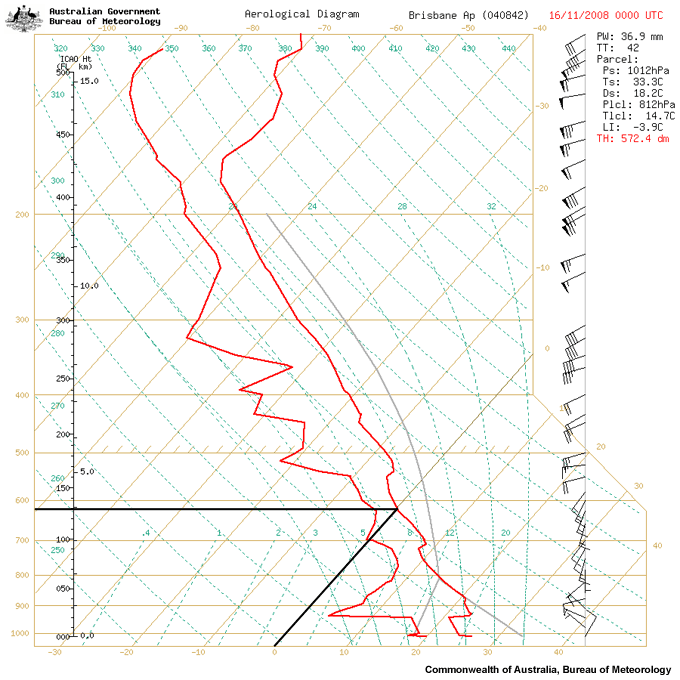
Representative proximity sounding used to determine the environmental freezing level required for the hail nomogram. The freezing level for the Brisbane area on 16 November 2008 was approximately 4 km.
- Using the Australian Climatology 50 dBZ hail nomogram, read off the critical height for 2cm hail (threshold for severe weather) using the freezing level determined from the sounding in step 1.
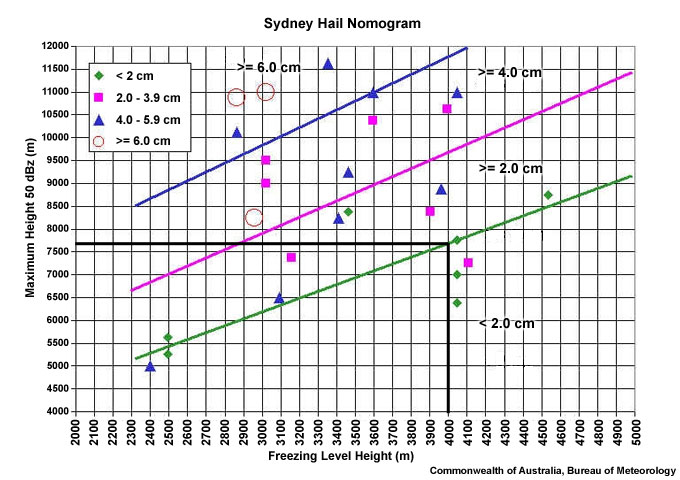
The hail nomogram is based on a hail climatology specific to the Sydney region, Australia. It was derived from observations using the 2º beam width S-band Sydney radar. There are several other limitations that need to be taken into consideration when using this nomogram, including:
- Single station climatology performed on a S-band radar
- Relatively small sample size used
- Radars are can be poor in calculating heights of target, due to:
- Partial beam filling
- Varying beam widths
- Refraction
- Add a CAPPI window to your radar display and set the height to the 2cm hail threshold altitude from step 2.
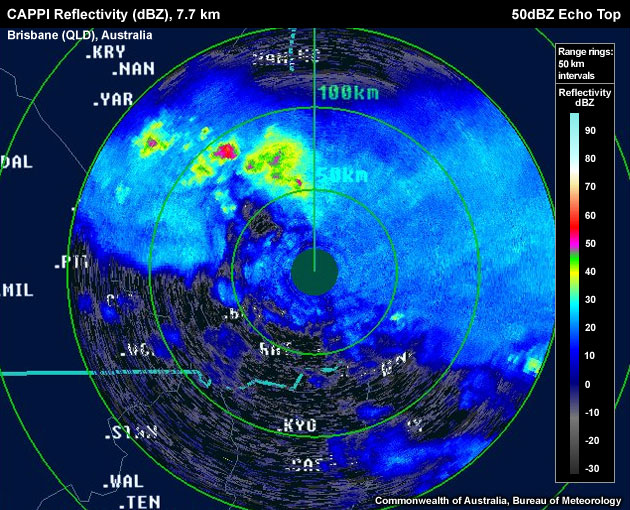
50 dBZ thunderstorm tops "breaking through the CAPPI" level set at the 2cm hail threshold height indicating the likelihood of large hail.
- Monitor the CAPPI window for breakthroughs of >50 dBZ echoes as candidate storms for further investigation.
Potential Difficulties in Detection
Radar Sampling:
- Calibration – with most colour palettes for reflectivities, values close to 50 dBZ start being displayed in reddish colours. If the radar underreads the reflectivity by only a few dBZ, 50 dBZ echo tops may be off by several kilometres
- Attenuation – especially on C–band radars, reflectivities in cores that are located down–range of another intense core are underestimated in intensity.
- Radar proximity – if a thunderstorm is too close to the radar, the beam may undershoot the signature
Examples of 50 dBZ Echo Top Heights
Note: The CAPPI height is not the "50 dBZ echo top height". To determine the "50 dBZ echo top height", place the cursor on the pixel and read off on the info bar at the base of the window.
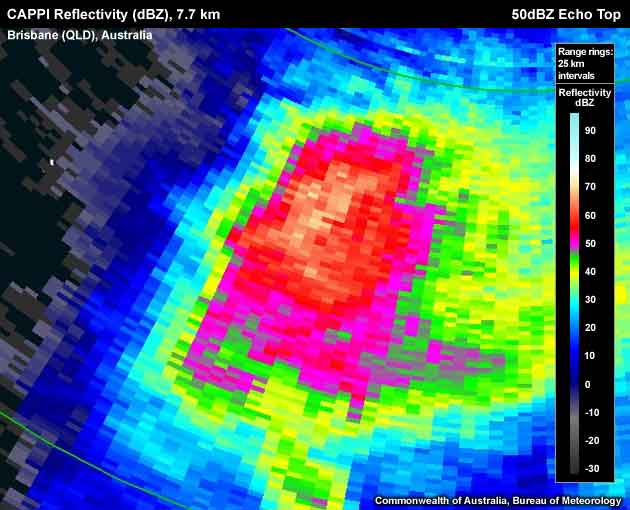
A large horizontal extent of very high reflectivities breaking through the 2 cm hail height on a CAPPI. The highest reflectivity is approximately 69.0 dBZ
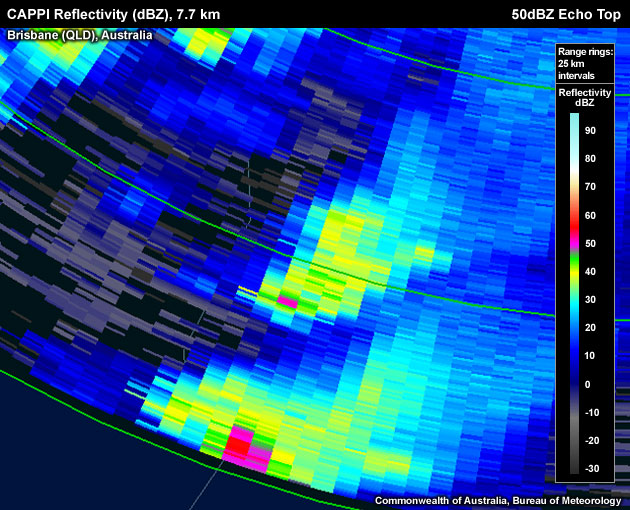
A few pixels with reflectivities greater than 50 dBZ breaking through the 2 cm hail height on a CAPPI. The highest reflectivity is approximately 50.5 dBZ. Note: a "single pixel breakthrough" is obviously a lot less meaningful than several pixels as shown above.
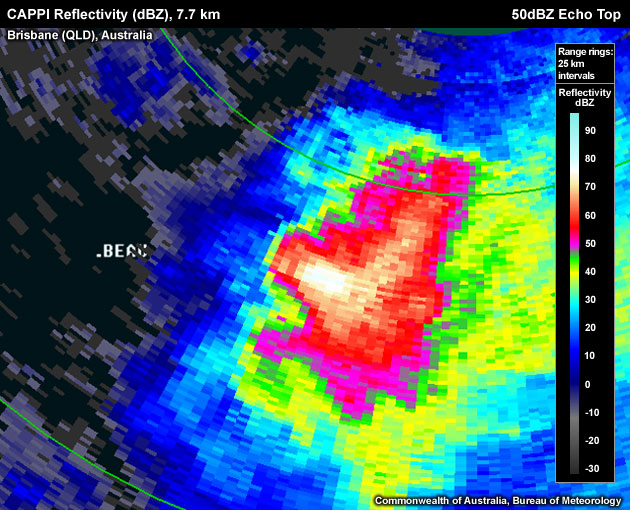
A large horizontal extent of very high reflectivities breaking through the 2 cm hail height on a CAPPI. The highest reflectivity is approximately 77.0 dBZ
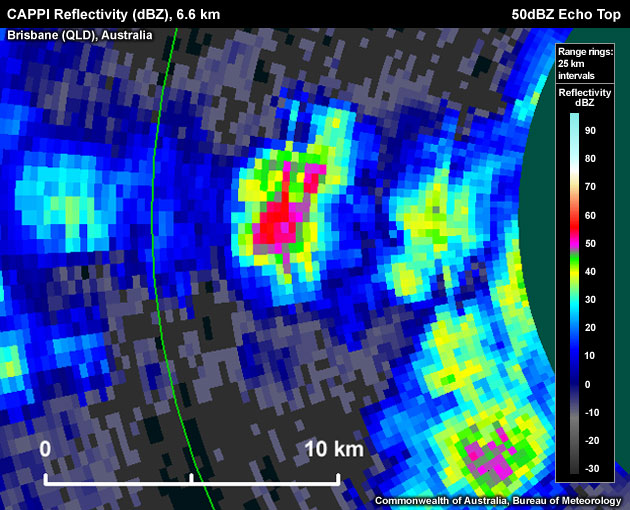
Small horizontal extent of reflectivities greater than 50 dBZ breaking through the 2 cm hail height on a CAPPI. The highest reflectivity is approximately 59.0 dBZ.
50 dBZ Echo Top Height Look–a–likes
- A small number of pixels – when using the 50 dBZ signature through the CAPPI techniques, a small number of 50+ dBZ pixels in the CAPPI level, amounting to a small red area of approximately 1 km2 or less, is not that meaningful as a proxy for 2 cm hail at the ground.
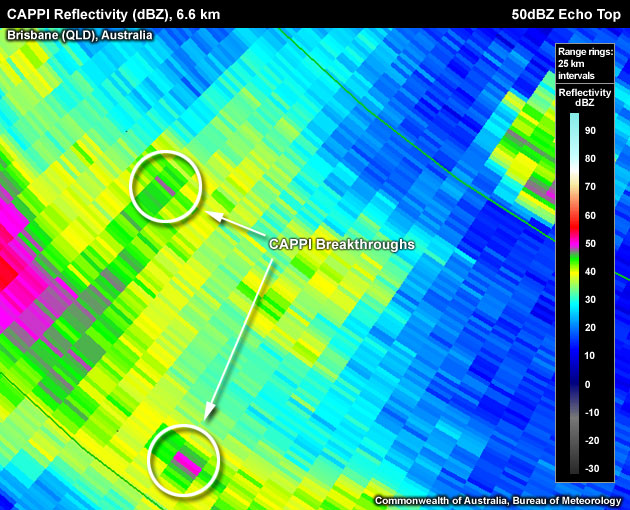
A small horizontal extent of pixels breaking through the CAPPI provides small confidence on large hail reaching the ground.
- Weak Reflectivities – echoes need to be greater than or equal to 50 dBZ. The standard Australian coulour palette uses a dark pink for pixels with reflectivities greater than about 45 dBZ. These can easily be mistaken for pixels with reflectivity values at or above 50 dBZ.
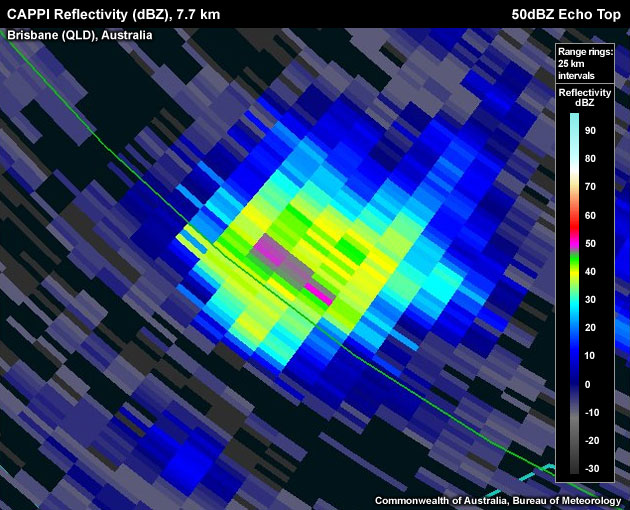
Relatively weak (less than 50 dBZ) but "reddish" reflectivities breaking through the CAPPI provide small confidence on large hail reaching the ground.
Conceptual Model
A 50 dBZ Echo Top Height is one of many signatures that points toward a severe thunderstorm. The presence of tall or elevated 50 dBZ echoes may indicate large hail. The ingredients needed for severe hail formation and growth include a strong, wide, persistent updraft in the hail growth layer (–10°C to –30°C). Once reflectivities reach values greater than 50 dBZ, it becomes increasingly likely that they represent hail. Large hail is among the likely severe convective hazards produced if this signature is positively identified.
Fig.1 shows that using the lowest PPI radar scan can make it difficult to find which core extends up into the hail growth layer.
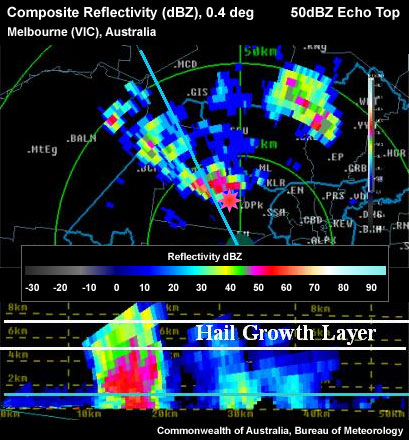
Fig. 1: Lowest elevation scan on PPI and RHI showing thunderstorm 50 dBZ echo top height. White lines denote the top and bottom of the hail growth layer (–10°C to –30°C), as determined by a local sounding.
Fig. 2 shows that a CAPPI display set to the nomogram-derived 2cm hail threshold height quickly allows an operator to spot where a vertical cross section should be placed for the interrogation of the most significant cores.
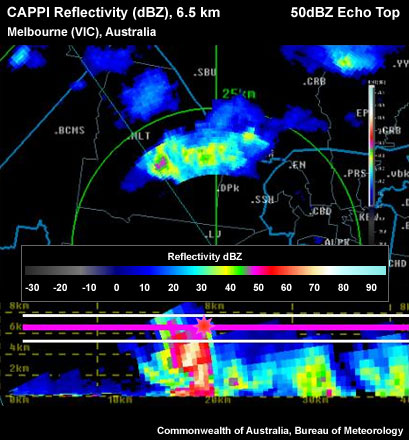
Fig. 2: CAPPI cross–section on PPI of the same storm as previous figure, showing 50+ dBZ pixels "breaking through the CAPPI". White lines denote the top and bottom of the hail growth layer (–10°C to –30°C), as determined by a local sounding.
Determining Thunderstorm Classification
The 50 dBZ Echo Top Height signature can be found in supercells and multicells. A significant 50 dBZ echo top height requires a strong and reasonably sustained updraft, which can be found in pulse severe thunderstorms, supercells, and also in both the multicell modes.
To help determine the classification of the thunderstorm you are observing, use the following flow chart. Alternatively, if you already know the conceptual model, simply click on the appropriate model at the end of the flow chart.
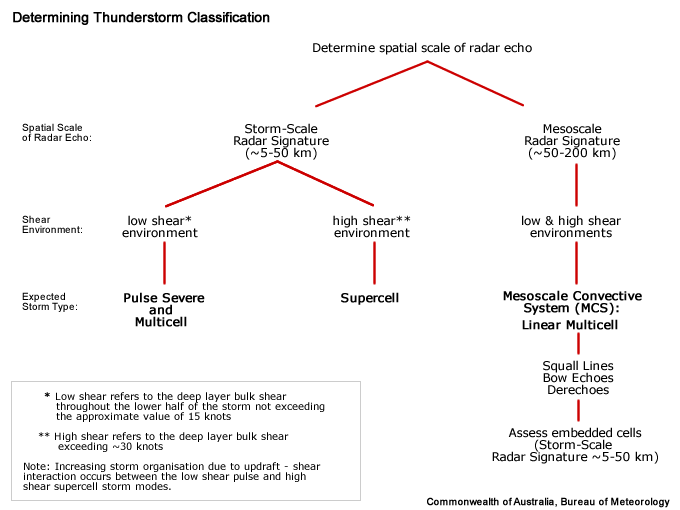
Diagnosis
Once you have confidently identified a 50 dBZ Echo Top Height signature, this section will help you estimate the storm severity associated with it. Generally, the spatial and temporal scales of a signature are loosely related to the updraft strength. In other words, the larger and/or more long–lived the signature, the stronger the updraft that produced it. In velocity-based signatures, updraft severity can usually also be gauged by the magnitude of the measured radial velocities. Examining a storm’s overall temporal evolution will suggest whether the storm is becoming more or less severe. Radar signatures and associated storm developments can also be time-shifted relative to each other, as is the case in supercell tornadoes that occur during the collapse of the parent storm.
When comparing signatures to diagnose relative severity, keep in mind that it is assumed that signatures are sampled at equal ranges from the radar. Otherwise, a storm sampled at greater range (with a wider beam) can appear to be weak and/or weakening, while a storm sampled at a closer range (with a narrower beam) can appear to be strong and/or strengthening.
Degree of Severity
- Horizontal Extent – The larger the area of 50+ dBZ reflectivity values at the 2cm CAPPI level the more likley the presence of large hail.

A few pixels with reflectivities greater than 50 dBZ breaking through the 2cm hail height on a CAPPI.

A large horizontal extent of very high reflectivities breaking through the 2cm hail height on a CAPPI. This second "CAPPI breakthrough" is far more meaningful in suggesting the storm's potential to produce large hail.
- Vertical Extent – The deeper the echoes greater than 50 dBZ above the freezing level, the more likely the reflectivities within the ideal hail growth layer are representing large hail.
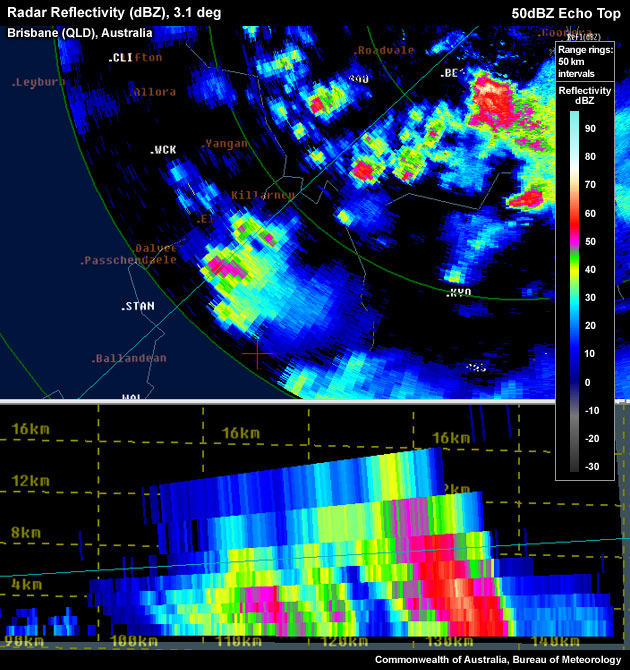
Short vertical depth of the 50+ dBZ echo (left) and a much taller 50+ dBZ echo which reaches approximatly 9 km (right).
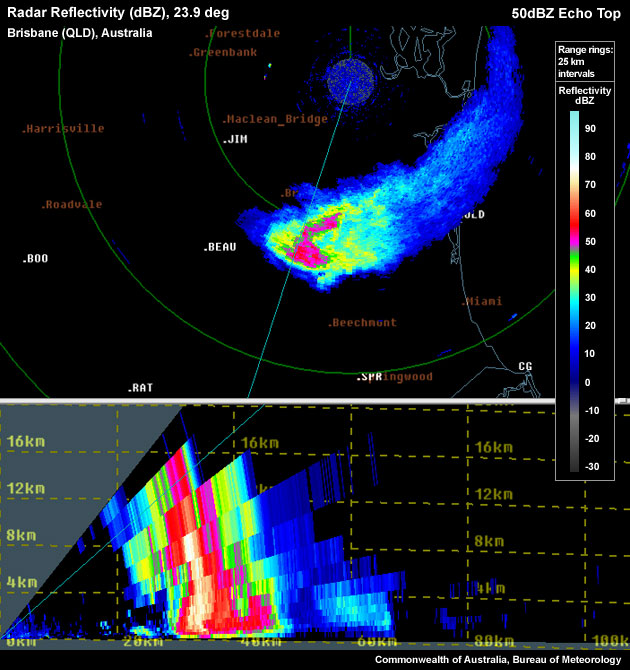
Tall vertical depth of 50 dBZ echoes. 50 dBZ echo top height reaches up to approximately 15 km.
- A different view of this is through the CAPPI window. The CAPPI doesn’t have to be set to the 2 cm threshold in the 50 dBZ nomogram. To monitor for high–end severe thunderstorms, a CAPPI level could be set well above the hail growth layer, corresponding to the 4 cm or 6 cm hail thresholds on the 50 dBZ nomogram. This is especially useful as a monitoring tool, distinguishing the more severe storms from the rest.
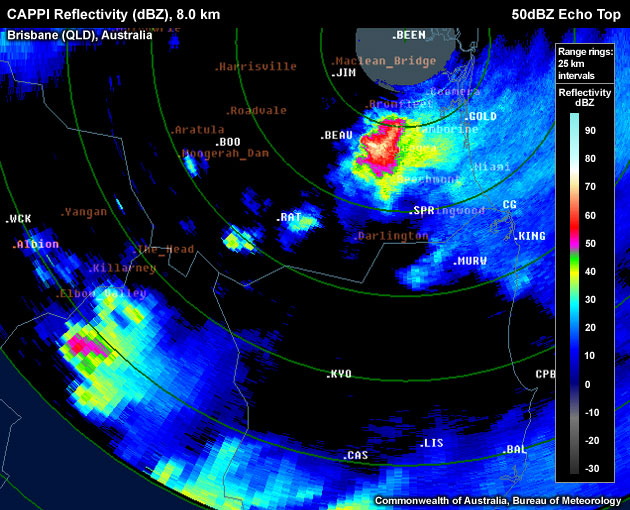
50 dBZ reflectivity breakthroughs at the 8km CAPPI level.
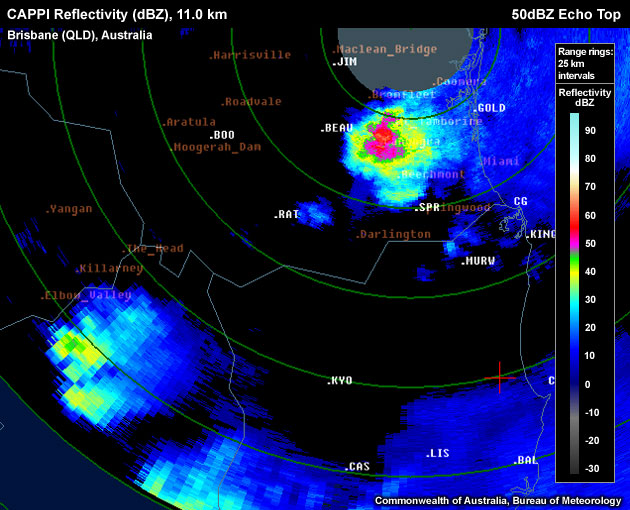
50 dBZ reflectivity breakthroughs at the 11km CAPPI level pointing towards the possibility of giant hail.
- Max dBZ – The higher the maximum dBZ value within the 2 cm hail CAPPI plane, the higher the probability that this storm is associated with large surface hail.
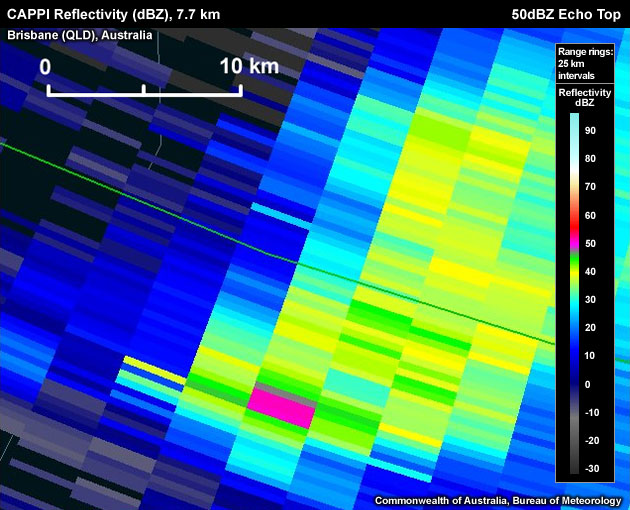
Maximum echo is approximately 50 dBZ

Maximum echo is approximately 77 dBZ
- Temporal extent – The longer the pixels with reflectivities greater than 50 dBZ "break through the CAPPI" level, the longer the potential residence times of hailstones within the ideal hail growth layer. This should increase forecaster confidence in the presence of large hail.
Loop of >50 dBZ echo "breaking through the CAPPI". Note the steady western storm persisting, whereas the eastern storm is much less steady.
- Hail Size Estimation – alternatively, the 50 dBZ hail nomogram could be used in reverse to estimate an approximate size of the hail, using the height of the highest 50 dBZ echo. To use this technique, peform the following:
Reflectivity: PPI/Plan View
- Step up in elevation scans until you run out of >50 dBZ echoes.
- Step back down one elevation scan.
- Centre cursor over the > 50 dBZ pixel furthest away from the radar. Read off the height. Note: this can be done using the scale bar on the right of display, the info bar at the bottom of display or via the cursor data on the main control window.

This thunderstorm displays 50+dBZ echoes extending to around 12 km, which (in just about any conceivable storm environment) is well past the hail growth layer.
- Equipped with the 50 dBZ echo top height of step 3 (e.g., 12 km), use the nomogram and the freezing level to read off the climatology-based estimate of the hail size. For this example the height is above the >6 cm hail threshold.

Considering all these aspects of the 50 dBZ echo top height signature will help determine overall whether you are dealing with a significant signature. Very tall 50 dBZ echo top heights (12 km or higher) would, in almost all cases, suggest a severe thunderstorm warning without additional corroborating evidence. However, radar information should never be used in isolation and should always be used in conjunction with observations from the near storm environment and any reports.
Most Likely Convective Hazards
If a thunderstorm has been determined to be severe and meets the required height for the production of large hail, the following convective hazards should be considered to be included in the severe thunderstorm warning:
- "Large hail" - with crude size estimates provided by the hail nomogram
- "Damaging winds" - likely due to the strong updraft that is required for large hail production, and therefore an associated strong downdraft
See Conceptual Models for more details on why particular severe weather should be included.
References/Addendum
None at this time.